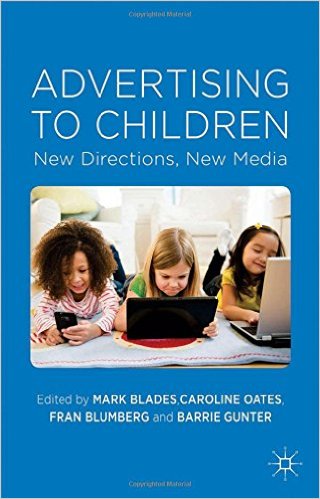 Editors: Mark Blades, Caroline Oates, Fran Blumberg, and Barrie Gunter
Editors: Mark Blades, Caroline Oates, Fran Blumberg, and Barrie Gunter
Publisher: Palgrave Macmillan – 254 pages
Book Review by: Laxmi Chaandi
Children have been a target of advertisers since before the beginning of the twentieth century, and particularly more so in since the start of its second half, century, the editors point out in their Introduction to this book.
The British government was concerned about protecting children from sellers of goods as early as the late nineteenth century, so legislation was passed in Britain aimed at such protection from merchants. Its enactment developed over concern about the ability of children to know “when someone is trying to manipulate them to purchase things.”
At what time in their lives can children discern whether or not a message is trying to persuade them to buy a product?
The answer from the editors: “Children may begin to make simple distinctions about advertising even by the time they start school, but their full understanding of how it works and what motives underpin it can remain ill formed until their teenage years.” This is based on three studies – in 1990 by Young; in 1997 by Gunter and McAleer; and in 2005 by Gunter, Oates, and Blades.
But present-day messages targeted at children use communication technologies “that embed commercial promotions within entertainment content and virtual communication environments, rendering them difficult to differentiate,” they point out.
These and other issues are part of the coverage of this book. Twenty-four people including the four editors named above authored the 13 sections of this book including the Introduction and Conclusions. They are in academia and research, teaching or studying, among other subjects: children’s learning and development, communication, management, marketing, media, and various subfields within psychology.
Below is an overview of what topics you will find discussed in it, based on its Contents:
- Introduction
- Do Very Young Children Understand Persuasive Intent in Advertisements?
- The Development of Children’s Scepticism About Advertising
- Commercial Food Promotion to Children
- Alcohol Advertising and Young People
- Advertising to Children in China
- Parents’ Beliefs About, and Attitudes Towards, Marketing to Children
- The Family’s Role in Interpretation of Advertising
- Linkages Between Media Literacy and Children’s and Adolescents’ Susceptibility to Advertising
- Under the Radar: How Embedded Commercial Messages in TV and the New Media Influence Children Without their Conscious Awareness
- Young Children’s Ability to Identify Advertisements on Television, Web Pages and Search Engine Web Pages
- The Influence of Advergames on Children’s Consumer Choices and Behavior
- Conclusions
The editors point out that while “generic concerns” about marketing to children continue to the present day, other specific concerns have arisen as they relate to child health and well-being, particularly about their unhealthy behavioral practices such as consuming wrong foods and drinks (those containing high amounts of fat, sugar, salt), alcoholic beverages, and cigarettes that contribute respectively to diabetes, obesity, hypertension, heart disease, and addiction to alcohol and tobacco.
In addition to the above, researchers have addressed the issue of the media prematurely inducing children into inappropriate sexual behavior by exposing them to advertising designed for adults, as well as created explicitly for children. The proliferation of sexually-suggestive radio and television commercials, as well as ads in print and digital media catering to teens and preteens have prompted parents to pressure legislators to pass laws banning them. Such issues are also addressed in this book.
The References section at the end of each chapter provides various sources of additional information and discussion. These sources are: research studies, articles in various academic journals and popular publications, as well as other books. Overall this is an excellent resource on the subject of advertising and marketing to children.
Editors:
Mark Blades – University of Sheffield, United Kingdom
Caroline Oates – University of Sheffield, United Kingdom
Fran Blumberg – Fordham University, United States
Barrie Gunter – University of Leicester, United Kingdom
Contributors:
Moondore Ali
Susan Auty
Mark Blades
Fran Blumberg
Emma Boyland
Monick Buijzen
Sandra Calvert
Kara Chan
Maria Chu
Barrie Gunter
Jason Halford
Joanne Harrold
Jane Herbert
Brian Kelly
Tim Kirkham
Charlie Lewis
Shiying Li
Nicki Newman
Caroline Oates
Laura Owen
Megan Pickering
Amanda Staiano
Athanasia Tziortzi
Jessica Williams







